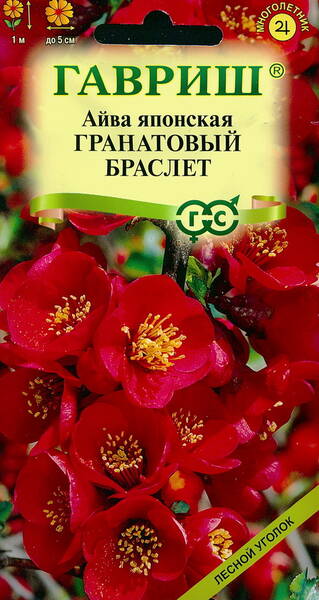A densely foliated shrub about 3 m high, with a dense crown up to 3 m. Young leaves have a bronze color, and adult leaves become dark green.
The flowers are large, 5 cm in diameter, scarlet-red, collected in shields of 2-6. In the temperate zone, it blooms in May, before the leaves bloom.
The buds open unevenly, and the flowering period stretches over 3-4 weeks. The first flowering of plants grown from seeds is noted in the 3rd - 4th year of life.
The fruits are edible, round, up to 6 cm in diameter, yellow-green, ripen in late September - October.
Name: translated from Greek, "chaenomeles" means "to split an apple".

Japanese Quince grows rather slowly: annual growth is 3-5 cm. It loves light, but tolerates light shading. It grows better on fresh fertile soils, tolerates drought and pruning well. It is frost-resistant, but in severe winters with little snow, the ends of the shoots are damaged by frost. Flower buds located closer to the ground are usually not damaged, the plants bloom and bear fruit every year.
Propagated by seeds, root suckers, layering, cuttings. A great advantage of this plant is its early flowering. It can be used for single, group, border and edge plantings, in hedges. It has been known in culture since 1874.
Location: sunny open places for Chaenomeles are better than shade, where they grow poorly. This crop usually has average winter hardiness; in frosty winters, the ends of annual shoots freeze. Therefore, for Chaenomeles, it is advisable to choose areas and places where enough snow accumulates in winter to protect against severe frosts (below -30 °C).
Soil: leaf soil, peat compost and sand in a ratio of 2:2:1. When planting, add organic and mineral fertilizers: 10 kg of manure, 200 g of superphosphate, 30 g of potassium nitrate per hole.
The best soils for Japanese Quince are considered to be light, well-moistened loams or sod-podzolic soils with a high content of organic matter and a slightly acidic reaction of the environment (pH 5.5-6.0). Soils with a pronounced alkaline reaction should be avoided, on which plants are severely affected by chlorosis.
Planting: when planting Chaenomeles, it is best to use two-year-old seedlings and plant in early spring before the buds open. Autumn planting is possible, but the seedlings should be earthed up!
In a hedge, the distance between bushes should be no more than 0.5-1.0 m, and in plantings - 1.5 m. It is important not to deepen the root collar (it should remain at soil level).
Care: three additional feedings are carried out during the summer: in the spring, nitrogen fertilizers are scattered around the bush, and after flowering and harvesting, phosphorus and potassium liquid fertilizers are added at the rate of 200 - 300 g per 10 liters of water. Watering is sufficient once a month. Loosen only when weeding. The soil around the bushes is mulched with peat, wood shavings or bark in a layer of 3-5 cm. Pruning is carried out once every 5-6 years; in the summer, after flowering, weakly developed, dry, broken, frozen or old (more than 5 years) branches are removed. When preparing plants for winter, do not forget to cover young seedlings with spruce branches.


Maule's Quince, Japanese Quince. Bot.syn.: Cydonia japonica Pers., Pyrus japonica Thunb., Chaenomeles maulei Schneider, Pyrus maulei Masters.












